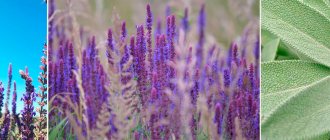Cherry image
Since time immemorial, the cherry orchard has been a symbol of family, unity and native land.
The smell of Cherry blossoms in the spring awakened tender memories and gave a sea of emotions in the summer, when the ripe berries no longer held on to the branches.
Cherries were a sign of the purity and softness of female nature, as evidenced by paintings of the 18th century.
In Christianity, cherries, like apples, are the fruit of paradise. The cherry tree itself is the tree of knowledge.
Cherry blossoms were a symbol of the bride in many regions. The Cherry Orchard was a favorite place for unmarried girls.
In Ukraine, the Cherry Orchard protected the house from evil spirits. It was believed that the inhabitants of dark corners and swamps would avoid such a house. As long as the Cherry Orchard lives, friendship and love will reign in the family.
In Japan, the blossoming Cherry Sakura marks the beginning of a new cycle in the life of the village. At this time, rice sowing began.
Where Cherry Grows
There are about 130 species of this plant, distributed throughout the world.
Common cherry is a cultivated plant and grows in gardens and parks. Due to their high nutrient content, Cherry and Cherry are valuable fruit and berry crops in many countries.
Wild Cherry species are found in the Himalayas, the Far East, Japan and China. This species is resistant even to severe frosts.
Steppe wild Cherry is found in Siberia, Kazakhstan, Bashkiria and the Volga region. It can also be found in the North Caucasus and the European part of Russia.
The homeland of the common cherry is the Black Sea coast. From these places the tree came to Rome and gained worldwide fame.
The tree is undemanding to soil conditions. Can be found in ravines and thickets near forest edges.
Late
Late variety cherries ripen in late summer or early autumn. They are more resistant to drought and disease, so they are suitable for breeding in the southern regions.
Vladimirskaya
Cherry has an almost black tint to the berries. They are quite large, weighing up to 7 g, with juicy, dense pulp and a well-separated stone. The fruits ripen in late July - early August. If you form a crown and water the plant, you can harvest up to 20 g of crop per season.
Related article:
Which cherry is better to plant in the Moscow region?
The plant is frost-resistant, unpretentious, and rarely gets sick. It is grown in the Urals and Siberia, where the crop bears fruit well.
Robin
This variety of fruit tree was bred in the 1980s of the 20th century in Russia. A plant with a spherical crown, up to 3.5 m high. The leaves are medium-sized, with a glossy surface and teeth along the edges. The fruits appear on last year's shoots.

The berries are round, burgundy, weighing up to 4 g, with a sweet and sour taste and juicy pulp. They are suitable for almost all types of workpieces. The bone is small and comes off easily. Malinovka is one of the highest-yielding varieties with excellent commercial qualities.
Turgenevka
A late-ripening variety developed in the 1970s. The trees reach 3-3.5 m, the shoots are straight, dark brown in color. The leaves are dark green, elongated, oval-shaped, pointed at the end.
Related article:
Feeding cherries: feeding options

The fruits are large, reaching a weight of 5 g. The skin is dark burgundy, dense. The pulp is juicy, burgundy, sweet and sour. The amount of sugars is 11%. An average of up to 20 kg of crop per season is harvested from one plant.
What does Cherry look like?
Cherry is a low tree or shrub.
The common cherry can reach 10 meters in height with a trunk diameter of up to 40 cm, while its wild fellow shrub reaches only 2 meters in height.
The Cherry root system is very powerful, so even the strongest winds are not capable of causing serious harm to the Cherry Orchard.
The age of some tree representatives can reach 100 years. Steppe wild Cherry lives only 15-20 years.
Mid-season
If we talk about which varieties of cherries are the sweetest, gardeners will no doubt call them mid-season. The harvest ripens in mid-July, so the berries have time to soak up the sun and sweetness. Mid-season varieties feel best in the southern regions of Russia.
Zhukovskaya
An old variety, obtained back in the mid-1940s. The trees grow 1.5-3 m high. The crown is spreading and round. The leaves are glossy, concave, ovate. Fruit ripening begins in mid-July, bearing fruit in the 4th year.
Related article:
Causes of poor growth and death of cherries, epidemics of moniliosis, coccomycosis
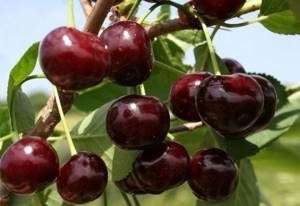
The berries are attractive, large, individual specimens reach 6-7 g, dark red in color. The pulp is dense, juicy, with a sweet and sour taste, which received the highest rating during tasting.
Podbelskaya
The variety was obtained back in the 19th century and has stood the test of time. Breeder K. Koch crossed the Spanish cherry Griot Ostheimsky and the European Lotovy. A variety was obtained that produces fruits with excellent taste.

The tree reaches a height of 5 m. The branches form tiers and grow from the trunk at an angle of 60-70 degrees. The leaves are oval, ovate, tapering towards the apex.
The berries are quite large, weighing 6 g, flat-round, with a flattened top. The peel is dense, glossy, almost black. The pulp is juicy, fibrous, veined, but tender and pleasant to the taste.
Related article:
If the cherry does not bear fruit and is capricious
The tree blooms early, the harvest appears in the 3-4th year of the plant's life. It bears fruit regularly, but the volume of the harvest increases gradually. In the southern regions, 50-100 kg are collected from one tree.
Rossoshanskaya black
Mid-season cherry variety with blue-black berries. The fruits reach 5 g, dense, juicy, fleshy. They are excellent for sale and transportation and do not deteriorate when transported over long distances.
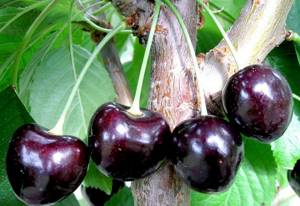
Fruiting begins in the 3rd year. During the season you can collect up to 15 kg from one tree. The culture is unpretentious and takes root well on any soil, both in the northern regions and in the south.
Solidarity
The variety was bred in the 1990s in Russia. A tree with a spreading, slightly drooping crown of medium density. The shoots are thick, brownish-brown. The leaves are elliptical, dark green, matte. Plants begin to bear fruit in the 4th year.
Related article:
Growing felt cherries
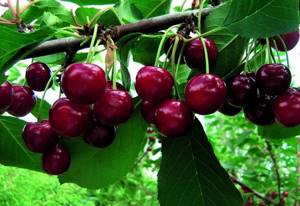
The berries are dark red, large, weighing up to 7 g. The top of the fruit is round, there is a small depression at the base. The pulp is pinkish, dense, and clarified juice is obtained from it. It is characterized by a sweet and sour taste, which during tasting received a rating of 4.6 points.
Medicinal properties of cherries
The fruits, bark, leaves and even flowers of Cherry are used for medicinal purposes.
The fruits contain vitamins B and C, sugars and organic acids, as well as magnesium, copper, iron, potassium and calcium, pectin, and tannins. Thanks to such a number of useful elements, the fruits are useful for people with low hemoglobin, anemia, as well as people with poor blood clotting.
In addition, the fruits will help strengthen intestinal motility and cope with constipation.
Cherry juice is used as an effective antipyretic.
Dried cherry tree sap is a good enveloping agent. A decoction of the stalks has an identical effect.
Cherry pits are dangerous if consumed internally, but the dried and ground product is used as compresses for gout.
Cherry leaves have antiseptic properties, so they are used when storing berries and other fruits.
Cherry water, obtained from cherry blossoms using steam, is an excellent remedy for treating eye inflammation.
Application of Cherry
The powerful roots of Cherry allow the plant to be used to strengthen slopes and dumps.
The wood is widely used in the production of high-value furniture and many joinery products and accessories.
The wood is processed into veneer and used in intarsia and marquetry.
Cherry fruits are widely used in cooking and modern medicine as a flavoring agent and as a food additive.
Thanks to the huge number of flowers, cherry orchards are valuable honey plants.
Cherry masks are used in cosmetics.
The fruits are consumed fresh. On an industrial scale, jams, wines, syrups and other products are made from the fruits.
Early
Varieties characterized by early ripeness produce a harvest already in early June and delight with long-term fruiting. In terms of taste, they are not inferior to mid- and late-season varieties. Early varieties are popular in Siberia and the Urals, where summers are cold and not all berries have time to ripen before the onset of cold weather.
Related article:
How to plant cherries correctly in spring and autumn
Bulatnikovskaya
One of the sweetest cherries, which has received numerous positive reviews. It was released in 1995. The tree is characterized by accelerated growth up to 3 m and has a spherical crown. The plant fits beautifully into the landscape and can be used not only for harvesting, but also as an element of the composition of a garden or personal plot.
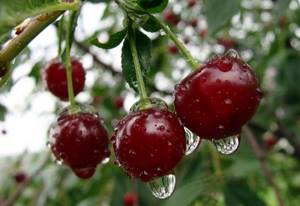
The first fruits appear at the 4th year of life. They have a sweet and sour taste, contain up to 10% sugar and 2% acids. Bulatnikovskaya cherries contain a lot of vitamin C - up to 28 mg per 100 g of product. The berries are dark burgundy, small, weighing only 4 g.
The Bulatnikovsky variety is ideal for growing in the north of the Russian Federation. In the south it takes root less well, but also bears fruit. The tree loves soils with a deep root system and does not tolerate waterlogging.
Related article:
Felt cherry. Growing, planting and care. Pruning and propagation. Varieties. Photo
Volochaevka
A hybrid variety obtained from crossing Vladimir and Lyubsk cherries. The tree is medium-sized, with a rounded crown. The leaves are dark green, ovate. The fruits are small, but very sweet, with a pleasant sourness. The pulp is juicy and pleasant.
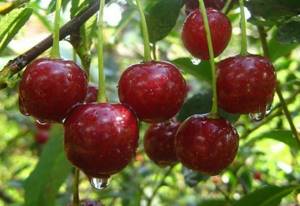
If you take good care of the plant, you can harvest up to 15 kg per season. The only drawback of the variety is poor frost resistance and susceptibility to fungal diseases.
Important: How to plant cherries correctly in spring and autumn
Sap
An early-ripening sweet cherry variety obtained by crossing the German variety Yellow Denisena and the Spanish Griot Ostheimsky. It was released in Belarus in 2002. The variety bears fruit in the first year. Gardeners fell in love with it for its unpretentiousness, frost resistance, and resistance to fungal diseases.

The tree is low, with a rounded crown. The fruits are medium, spherical, dark burgundy. The bone is small and comes off easily. The taste is sweet and sour, the juice is rich, ruby in color.
Related article:
Feeding cherries: feeding options
Cherries begin to bear fruit at 3-4 years. On average, trees produce crops within 15-25 years. But since Zhivitsa is a young variety, it has not yet passed the test of time.
Baby
A dwarf compact variety, the tree height reaches 2.5 m. This variety was bred in Saratov from the Early variety and Duke. The trees are bushy and small, so they are easy to harvest. You can get up to 20 kg of berries from one plant.
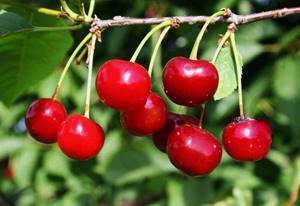
The fruits are burgundy, juicy, with easily separated pulp, weighing up to 5 g. They have a glossy surface and an attractive appearance. Sugar content – 7.5%. On a five-point scale, the taste of cherry received the highest rating.
Miracle Cherry
This is one of the sweetest varieties of cherries, which is also called Duke. According to the branching characteristics, the tree is very similar to the cherry. The crown quickly stretches out and becomes pyramidal. To prevent it from growing, pruning is carried out and the tree is given a spherical shape.
Related article:
Felt cherry: photo and detailed description of felt cherry
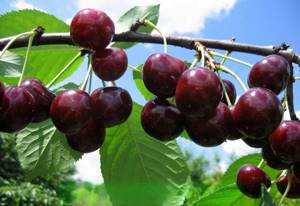
The berries are large, burgundy, weighing up to 10 g, with thick skin. The taste is very reminiscent of cherries: sweet, without sourness. The pulp has a pronounced cherry aroma, but at the same time cherry notes can also be discerned.
The first fruits appear already in 2-3 years. On the fourth, it is possible to collect a full harvest - up to 10-15 kg. Fruiting begins at the end of June, berries appear annually.
Interesting: Which cherry is better to plant in the Moscow region




